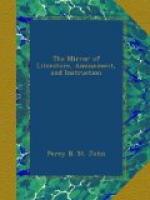Wandering eastward, we arrive at the precincts of Fountains Abbey, which gradually presents its monastic turrets midway in a dell, skirted by hills crowned with trees, and varied by rocky slopes to the brook. This abbey was founded in consequence of the disgust which certain monks of the Benedictine order at St. Mary’s, York, had imbibed against their relaxed discipline; when struck with the famed austerities of the monks of Rievaulx, they left their abode, and retired to this valley, under the shade of seven yew trees, six of which were (in 1818) standing. The abbey was destroyed in the reign of Stephen, and rebuilt in 1204.[4] The present ruin is celebrated for the sublimity of its architecture, many parts of which are as perfect as when first erected. The tower is 160 feet in height, and is a fine specimen of Gothic, in its best taste. It may with safety be asserted, that no church or abbey in England can boast of such an elegant elevation. The cloisters, 270 feet in length, and divided by 19 pillars and 20 arches, extend across the rivulet, which is arched over to support them; and near to the south end is a large circular stone basin. This almost subterranean solitude is dimly lighted by lancet windows, which are partially obscured by oaks, beeches, and firs; and the gloom is heightened by the brook beneath, which may be seen stretching its way through the broken arches. The only tomb in the church is that of a cross-legged knight, which lies near the grand tower, and represents one of the Mowbrays, who died at Ghent, in 1297. Near the altar is a stone coffin, in which, according to Dugdale, Lord Henry Percy was interred in 1315. Contiguous to the church is an extensive quadrangular court, which has been converted into a flower garden. On the east side is a line of beautiful arches, under one of which is the entrance to the chapter-house, a weed-grown solitude of deadly silence—




